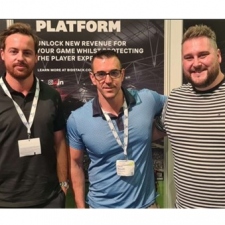Bidstack has continued to be an intriguing new presence in the world of mobile advertising. With the aim of bringing intrinsic advertising to new titles across the mobile world and beyond, the company is part of a wider vanguard of adtech seeking new means to advertise effectively.
We spoke to vice president of enterprise partnerships, Chris Vincelli, vice president of gaming, Antoine Jullemier and finally, vice president of marketing, Lewis Hadley. With a chance to speak to an unprecedented group key to Bidstack’s ongoing efforts to bring intrinsic in-game advertising to the world of mobile and beyond, we got an excellent idea of where the ambitious adtech company is headed in the near future.
For those not familiar, Bidstack is an adtech company specialising in the placement of advertisements in a virtual world. Unlike traditional advertisements on mobile, like interstitial ads, which interrupt gameplay, these adverts appear on signage, billboards and other appropriate locations in the game world. Bidstack Sports is, of course, a subdivision that plans to capitalise on the prevalence of advertising in real-world sporting venues and bringing that kind of visibility to gaming.
So with three VPs on board, let’s dive into what’s new about Bidstack...
PocketGamer.biz: So we know Bidstack specialises in intrinsic advertising, but can you break down what that actually means in a technical sense?
Chris: So what Bidstack really does is provide premium game publishers and developers with a centralised platform to dynamically control and natively monetise any digital asset within in-game environments. What that platform does is enable publishers to enhance the user experience, deliver relevant and targeted messaging to support LiveOps, and accelerate revenue generation by allowing publishers to capture more relevant sponsorship dollars while removing the need to hard-code assets
Why do you think players and users, and indeed brands and developers, prefer it?
Antoine: I don’t know if they prefer that, but I know they like it for sure. They can feel the ad pressure on the market. You now have more and more games, all these placements that can be intrusive as you play, like full-screen interstitials, unskippable videos, and banners popping out everywhere. These publishers are losing more and more users. The churn rate is a difficult KPI to control, and we see more and more publishers looking for innovative formats that are more user-friendly, and that might have to compensate for the loss of revenue they’re making from losing users.
Do you think intrinsic advertising is the way forward in terms of adtech then?
Antoine: I think, for us, it’s definitely the way forward if you’re looking at scale, but for others, it’s probably not the only option. You may have brand sponsorships that can go beyond creatives, such as skins or branded tournaments in line with esports. But I think intrinsic in-game advertising is definitely a good option to consider in order to sustain success in this quickly evolving market. It’s still in the early stages, and this format is going to quickly transform in the years ahead.
What do you think of the conjunction between traditional sports and advertising and why does it work so well?
Chris: One of the reasons it works so well is that if you’ve ever visited a stadium for a live sporting event, in-stadium sponsorships are already part of the stadium and fan experience and have been for decades. It is clear that brands have been finding value in these stadium activations by creating a deeper positive and emotional connection with the fanbases.
Our focus at Bidstack Sports is to map those exact real-world stadium placements and activations to the same stadium but in the virtual world. By doing so, Bidstack Sports is able to increase the realism of the virtual stadium experience, provide scaled brand amplification for the sponsors, and 24/365 fan engagement for the clubs and teams on a global scale.
How does Bidstack really appeal to brands and developers?
Lewis: From a brand point of view, if they’re advertising in traditional environments such as in-stadium advertising, they’re doing that because of the association with the sport, the emotional impact of the event, and the reach. But what they don’t have is the data behind that. They have topline numbers, ‘x amount of a million people watched it in this geo’, but in a gaming environment, there’s a lot more data underpinning that. Of course, a lot of it is anonymised, but we can understand what device they’re playing on, what location they’re in, what age they are, and we can even age-gate, for example, so it can be safer in some senses.
If you think about betting brands, for example, being pitchside at a football game or on the front of a football shirt in a gaming environment, we can make it so that only people over 18 in the UK can see that advertising. So it’s essentially taking that traditional model and bringing it forward a number of steps.
From a feasibility and cost side of things, what do you think makes Bidstack more unique and appealing than other adtech companies?
Antoine: I think we’re definitely helping the brands to get into games directly. They’ve been around for a long time, and you can see major activations in some of the biggest AAA games, like Fortnite, for example. These deals can be six or seven-figure sums and can take six months to a year to accomplish. But thanks to companies like Bidstack, we can allow companies to have dozens of deals within that timeframe that are programmatic, so we don’t have to break the bank when it comes to smaller developers. They can multiply the touchpoints across the audience of multiple games with dual-targeting options, so it’s way easier for them to enter the world of gaming through these new innovative methods.
Lewis: Just the fact that, with our form of advertising, because it can be delivered programmatically, it can be seasonal and reactive, and the messaging can change depending on what’s happening. Some brands like to have fun with their audience and interact with what’s happening in real-life sports, or they might be running a campaign for a particular time of year, for example. Being able to be reactive to that very quickly is an advantage of advertising programmatically with us.
Where does mobile fall in Bidstack’s considerations?
Antoine: Mobile is still the main platform that we work with in terms of scale - I’d say 85% of our games are on mobile today. While we tend to work with as many AAA games as possible across PC and - maybe tomorrow - consoles, realistically, the audience is on mobile, as everyone’s got a mobile, and almost everybody is playing games. We work with leading studios such as Ubisoft, Turborilla and Miniclip, and they’ve all got millions of users connected to their games every day, whether they are on the move or relaxing at home, so that’s why it’s very important to us. Mobile is, and probably will remain, a key platform for us.
In terms of sports fans, a lot of them are mobile gamers – they’re older and more into traditional media, Facebook Dads if you will. Do you this makes them a comfortably familiar audience for these brands?
Chris: Yeah, absolutely one of the most attractive benefits of mobile gaming is the scale and diverse audience it's able to generate. Also, it is really special that mobile games are played throughout a gamer's daily routine, from commuting to work, at work, during dinner, and before bed. In terms of sports games, some of the most established sports video game franchises have mobile versions. The mobile versions of these established franchises provide a game outlet for the Facebook Dads who grew up playing these games, as well as capturing the attention of next-gen sports fans.
What Lewis was saying earlier was that our technology enables brands to create targeted and sequential campaigns that align with real-world events, which align with a mobile games userbase without requiring the studios to invest in constant updates.
Apparently Bidstack has some major partnerships with the NFL in the works. Can you tell us a little more about that?
Chris: Going back to an earlier point about how we’re really trying to break that traditional ad tech mould, we recently put out an announcement with the Washington Commanders, which is one of the 32 NFL football franchises.
That partnership allows us to execute and evolve the Bidstack Sports strategy with an NFL club inside NFL Pro Era, which is an official NFL licensed game. Bidstack Sports will be mapping the real-world stadium placements to the virtual environment. I’m really excited that this approach breaks the traditional ad tech commercial structure by creating value for the entire partner ecosystem by aligning incentives.
It has been motivating to partner with an innovative club that is aligned with the vision and believes in the value it can provide to its current partners and global fans.






















